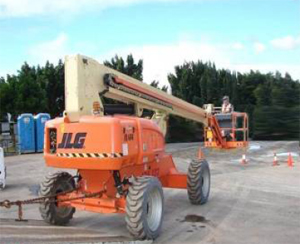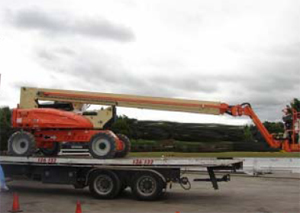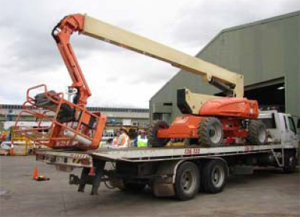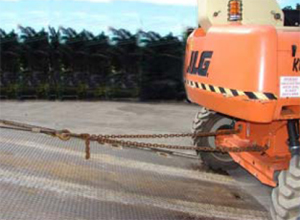Safe loading of elevated work platforms on tilt tray trucks
Issued: 29 September 2009
Last Updated: 4 April 2014
Purpose
The purpose of this alert is to inform people of the risk of injury when loading and unloading elevating work platforms (EWPs) onto and off tilt tray trucks.

Photograph 1: Loading an EWP onto a tilt tray truck.
Background
An incident occurred in Queensland when an EWP slipped down the tray of a tilt tray truck. The operator was located in the basket and drove the EWP up the tilted tray to load it onto the truck for transportation. Photograph 1 shows an EWP being loaded onto a tilt tray. The truck tray used for transporting the EWP was too short to enable the EWP to be placed in the transport (stowed) position without the basket overhanging the tray. Photograph 2 shows a view of the EWP with the basket overhanging the tray. To prevent overhang the basket was rotated under the boom ('crowded' position) as shown in Photograph 3.
When the basket was placed in the crowded position and lowered onto the tilted tray, the braked wheels nearer to the basket lifted off the tray. The remaining wheels in contact with the tray were not fitted with brakes. The winch cable was not attached to the EWP, which allowed it to roll down the slope of the tray. This movement caused the basket of the EWP to strike the ground. The operator was crushed between the basket's handrail and the ground, inflicting serious bodily injuries.

Photograph 2: EWP in travel position as specified by manufacturer on a tilt tray that is too short, allowing basketto overhang the truck.

Photograph 3: EWP in crowded position on levelled tilt tray truck.
Actions required to minimise the risk of injury
For the safe loading of EWP's, the following is to be ensured:
- The EWP is loaded and unloaded according to the EWP manufacturer's instructions.
- Always winch the unmanned EWP on/off the tilt tray unless the manufacturer's instructions allow it to be driven.
- Use the winch if the tray surface or EWP's tyres are slippery or if the slope of the tray is too steep for the EWP.
- The truck must be on firm level ground with no side slope. The winch may not stop the EWP from falling off the tray if loading with a side slope in slippery conditions.
- The truck is suitable to transport the EWP in the travel (stowed) position as determined by the EWP manufacturer. The tray or trailer should be long enough for the boom and basket in the travel (stowed) position. The mass of the EWP is to be within the capacity of the winch, truck and/or trailer.
- The operators of EWP's are provided with operating instructions and must be adequately trained for its operation. This is especially critical in relation to loading and unloading EWP's onto and off tilt trays.
- The EWP is transported in compliance with Department of Transport and Main Roads requirements.
In addition the following factors should be considered:
- Transport EWP's on a drop deck trailer (low loader) rather than a tilt tray truck.
- Use of the winch by another person at the same time that the EWP is driven up or down the slope of the tray, (see Photograph 4).
- If placing the basket onto the tray is recommended by the manufacturer, level the tilt tray prior to placing the basket onto the tray.
- Use the ground controls when placing the basket onto the tray.

Photograph 4: EWP being driven up tilt tray with winch cable attached and operated simultaneously.
Routine maintenance
A competent person should be engaged to carry out inspections of all critical components at least annually or as prescribed by the manufacturer. This includes but is not limited to the inspection of the winch, winch cable, chains, tie down points and EWP brakes. A record of the above activities should be maintained to provide a history of the plant.
Legislative requirements
The Work Health and Safety Act 2011 imposes health and safety duties on all persons conducting a business or undertaking whether as employer, self-employed person, designers, manufacturers, suppliers, installers and owners of plant and workers.
The information contained in this alert is designed to help persons meet their duties regarding the management of risks associated with loading and unloading EWPs for transportation purposes.